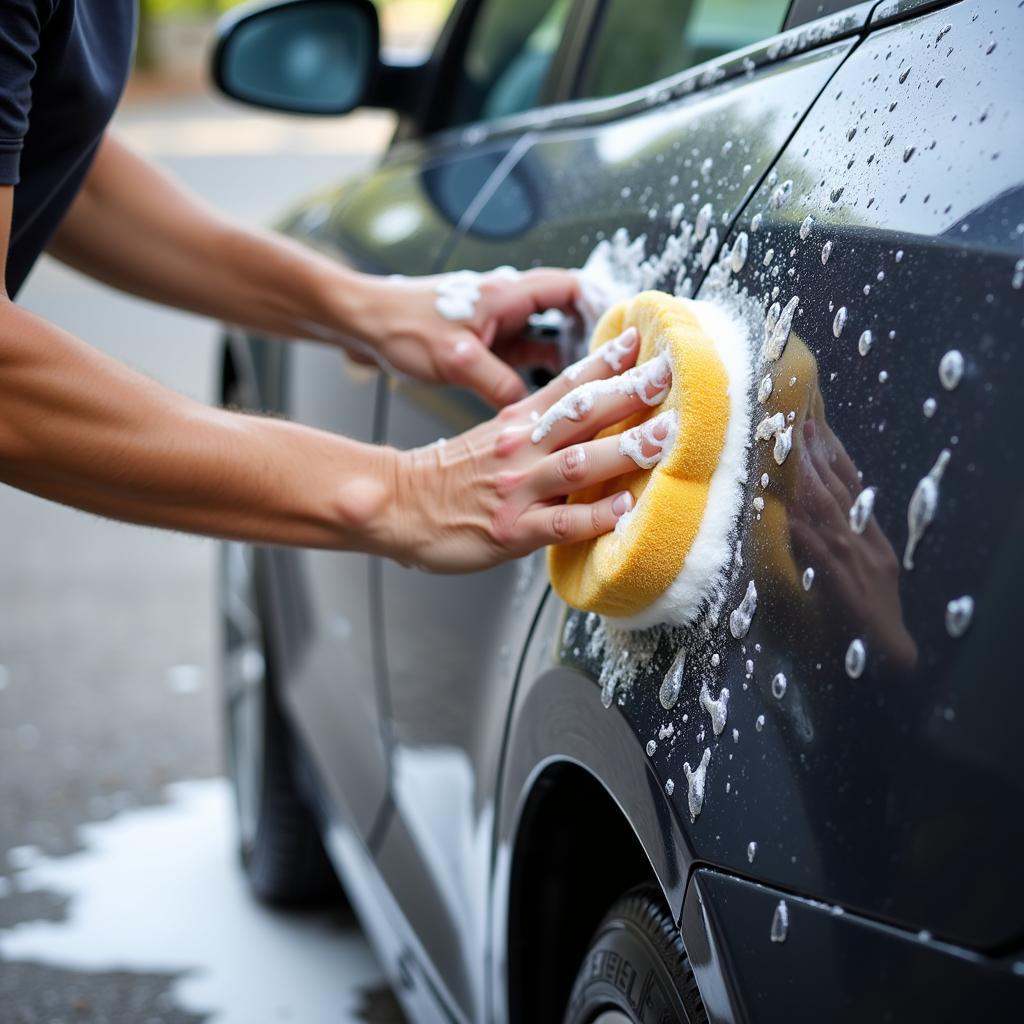Rust spots on your car’s paint are more than just an eyesore; they’re a sign of corrosion eating away at your vehicle’s metal. Left untreated, these small blemishes can grow into significant problems, compromising the structural integrity of your car and ultimately leading to costly repairs. Fortunately, addressing rust spots early on is often a manageable DIY project. This comprehensive guide will walk you through the process of how to repair rust spots on car paint, providing you with the knowledge and techniques to restore your car’s appearance and protect it from further damage. Let’s dive in and learn how to tackle those pesky rust spots effectively.
Rust, the reddish-brown scourge of car owners everywhere, forms when iron reacts with oxygen and water. This electrochemical process, known as oxidation, can quickly escalate, especially in humid climates or areas where road salt is used. Identifying rust in its early stages is crucial for preventing extensive damage. Look for small bubbles or blisters in the paint, reddish-brown discoloration, or a rough, flaky texture. Once you’ve spotted these telltale signs, it’s time to take action.
Assessing the Damage: Know Your Enemy
Before you begin the repair process, you need to assess the extent of the rust damage. Is it surface rust, affecting only the paint layer, or has it penetrated deeper into the metal? This determination will dictate the appropriate course of action. For minor surface rust, sanding and repainting might suffice. However, deeper rust requires more extensive repair, including potentially patching or replacing the affected metal.
If the rust has eaten through the metal, creating holes, you’ll likely need professional help. However, for smaller rust spots, you can often repair them yourself. This saves you money and gives you the satisfaction of restoring your car’s finish.
Gathering Your Arsenal: Tools and Materials
Once you’ve assessed the damage, gather the necessary tools and materials. For most rust spot repairs, you’ll need:
- Sandpaper (various grits)
- Rust converter
- Primer
- Automotive paint (matching your car’s color)
- Clear coat
- Masking tape
- Drop cloths
- Safety glasses and gloves
- Applicators (brushes, spray cans, or touch-up pens)
Make sure you have the correct color paint for your car. You can usually find this information on a sticker inside the driver’s side doorjamb or in your owner’s manual.
Step-by-Step Rust Repair Guide
Now, let’s get down to the nitty-gritty of how to repair rust spots on car paint.
-
Prepare the Area: Clean the rusted area thoroughly with soap and water, then dry it completely. Mask off the surrounding area to protect it from overspray or sanding.
-
Remove the Rust: Use sandpaper to remove the rust. Start with a coarser grit (e.g., 80-grit) and gradually move to finer grits (e.g., 220-grit) until the surface is smooth and all rust is gone. For deeper rust, you might need a wire brush or a rotary tool with a sanding attachment.
-
Apply Rust Converter: Once the rust is removed, apply a rust converter to the affected area. This chemical treatment converts the remaining rust into a stable, paintable surface. Follow the manufacturer’s instructions carefully.
-
Prime the Surface: After the rust converter has dried, apply a thin, even coat of automotive primer. This will provide a good base for the paint and help prevent future rust formation. Allow the primer to dry completely.
-
Apply the Paint: Apply several thin coats of automotive paint that matches your car’s color, allowing each coat to dry before applying the next. Use smooth, even strokes to avoid runs or drips.
-
Apply Clear Coat (Optional): If desired, apply a clear coat to protect the paint and give it a glossy finish.
-
Remove Masking Tape: Carefully remove the masking tape after the clear coat has dried.
“A common mistake people make is applying too much paint at once. Multiple thin coats are always better than one thick coat,” advises John Smith, Automotive Restoration Specialist at Classic Car Care. This ensures a smooth, even finish and prevents runs or drips.
Preventing Future Rust
Regularly washing and waxing your car can help prevent future rust formation. Keeping your car clean removes dirt and grime that can trap moisture against the metal, accelerating the rusting process. Waxing provides an additional layer of protection against the elements. “Regular maintenance is key to preventing rust,” says Maria Garcia, Lead Technician at Garcia’s Auto Body. “Just like regular oil changes are important for your engine, regular cleaning and waxing are crucial for protecting your car’s body.”
how to spot repair paint on car
Inspect your car regularly for any signs of rust, especially after winter or if you live in a coastal area. Addressing rust spots promptly can save you time and money in the long run.
 Washing and Waxing a Car to Prevent Rust
Washing and Waxing a Car to Prevent Rust
Conclusion
Repairing rust spots on your car paint is a manageable DIY project that can prevent further damage and restore your car’s appearance. By following the steps outlined in this guide, you can effectively tackle those rust spots and protect your car from future corrosion. Remember to assess the damage carefully, gather the necessary tools and materials, and follow the instructions diligently. Taking proactive steps to address rust spots will not only enhance your car’s aesthetics but also preserve its value and longevity. Don’t let those rust spots get the best of you – take action today!
FAQ
-
Can I repair rust spots myself? Yes, you can often repair minor rust spots yourself. However, if the rust has penetrated deeply into the metal, you might need professional help.
-
What causes rust on car paint? Rust forms when iron reacts with oxygen and water. This process is accelerated by road salt and humid climates.
-
How can I prevent rust on my car? Regularly washing and waxing your car, along with prompt repair of any chips or scratches, can help prevent rust.
-
What type of paint should I use for rust repair? You should use automotive paint that matches your car’s color.
-
Do I need to use a rust converter? Yes, using a rust converter is recommended to neutralize any remaining rust and prevent it from spreading.
-
What grit sandpaper should I use for rust repair? Start with a coarser grit (e.g., 80-grit) and gradually move to finer grits (e.g., 220-grit).
-
How long does it take for rust repair to dry? Drying times vary depending on the products used and the environmental conditions. Always follow the manufacturer’s instructions.
Need help with other car repairs? Check out our articles on rust repair paint car and car paint scratch repair poole.
For further assistance, please contact us via WhatsApp: +1(641)206-8880 or Email: [email protected]. Our customer support team is available 24/7.


